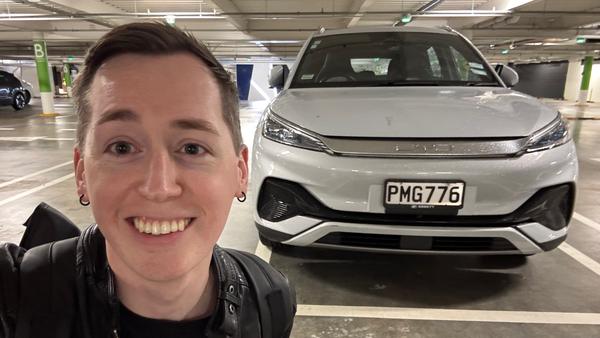
Around the world, there’s a big push to increase the adoption of electric vehicles. For some, it’s motivated by concern about climate change and the emissions reductions that electrification is promised to deliver, while for others it’s more of an economic play because incentivizing the purchase of electric cars won’t just be great for automakers, it will require a lot of manufacturing jobs and a vast increase in mining to supply battery supply chains. We could dig into all the potential implications of that — and I have, on multiple occasions — but there’s also a deeper problem in the push for electric cars as our transport solution.
The climate crisis requires us to look at many different aspects of society and ask whether the various systems we rely on should continue into the future or be completely rethought for a better, more sustainable world. Transport is not immune from that. Yet the efforts of automakers and related industries, as well as many political leaders, is to constrain the extent of that questioning. The argument being made is that as long as we electrify transportation, we don’t need to ask deeper and more fundamental questions about how we get around. The goal is to electrify the system that exists, then continue as we did before. But that’s not good enough.
Transport emissions are a serious problem. In the United States, it’s the largest sectoral contributor, accounting for 27% of US emissions, while globally it’s about 24% of total emissions, so it’s clear that action needs to be taken. But it would be wrong to suggest that’s the only problem that exists in our transport system, which has been designed around forcing car dependence on the public through decades of policy decisions lobbied for by industry. There’s a reason so many people live in car-oriented suburbs with few alternatives; they forced people to buy cars, and that worked for many different sectors of the economy. Those decisions have had a lot of consequences.
In the United States, 46,000 people are estimated to have been killed by cars in 2022 — an increase of 22% since before the pandemic. People spend on average more than two days of their lives every year stuck in traffic (and much more in some cities), and all that time in the car is linked to a ton of negative health effects. On top of that, building our communities for cars is much more expensive to maintain, requiring a higher tax burden because population density is so low, and it’s also very expensive for the individual.
In 2022, the American Automotive Association estimated that the average cost of owning a car is now over $10,000 a year — a huge burden when 64% of people in the United States report living paycheck to paycheck. New numbers from Edmunds suggests that’s only going to get worse. 16.8% of new vehicle buyers have monthly payments over $1,000 a month, up from 6.2% in 2021, even as the average down payment has continued to rise to nearly $7,000 and the length of an average car loan is about 70 months.
That’s in part driven by rising interest rates, but also a longer trend of larger vehicles translating into higher car prices that has only further taken hold during the pandemic. The average price of a new vehicle in the United States hit $49,500 at the end of 2022, rising from $38,948 just three years earlier. A quarter of all vehicle sales are over $60,000, while only 4% are under $25,000. Five years ago, there were 36 options under $25,000; that’s now fallen to just ten.
Over that same time, many US automakers have been withdrawing from the sedan market in favor of selling larger crossovers, SUVs, and trucks that have higher price tags which translate to more profit for automakers. But they also have many more negative social costs. Pedestrians are 2-3 times as likely to be killed when hit by an SUV or pickup truck than a sedan, and those larger vehicles are also more likely to hit pedestrians. Meanwhile, SUVs were the second largest contributor to increased global emissions from 2010 to 2018, and they’re wiping out the gains made from fuel efficiency and increased sales of electric vehicles.
There’s little question that electric vehicles have some environmental benefits, though I would argue they’re often misleadingly overstated to present them as a guilt-free alternative to the status quo that works for industries and governments seeking to present themselves as climate champions without actually challenging existing power structures. That’s especially the case when the EV market, particularly in North America, is following the decades-long trend toward larger vehicles and all the consequences the come along with it. When the Hummer EV is presented as a green choice and example of what a sustainable vehicle looks like, it’s a deep failure for anyone who gives a damn about a liveable planet.
So, while there will be some emissions reductions — though certainly not an elimination of transport emissions — from a shift to EVs, all those other problems are not addressed. Electric vehicles still tend to be more expensive than conventional vehicles, though they are beginning to come down, and that partially depends on commodity prices not spiking in the future. They can be cheaper to run, though that also depends on energy prices. One of my fears is that a lack of planning for the quantity of power necessary for millions of electric vehicles could have unforeseen consequences for the energy grid, and by extension utility rates.
Electric vehicles are also quite a lot heavier than their internal-combustion counterparts, especially because of the massive batteries with excessive range they’re expected to be equipped with. With the push to ensure the EV market remains focused on SUVs and trucks instead of smaller cars, that’s a serious safety concern — one that’s even been flagged by the National Transportation Safety Board. With road deaths already going in the wrong direction, it wouldn’t be great if our supposedly sustainable solution led to even more carnage on the streets.
Automakers are also seeing the move to electric vehicles as an opportunity to double down on adding more tech and internet connectivity to their cars, which may seem consumer-oriented, but comes with a number of drawbacks. The increasingly large infotainment systems in cars have been found to make drivers more distracted, while all those features allow companies to collect far more data on the vehicles they sell and the people who drive them. Tesla employees even shared photos and videos from their customers’ vehicles in internal group chats showing intimate moments and a child being hit by a Tesla.
Those systems also enable new business models by allowing automakers to charge for features that are already built into the vehicle. Tesla has been doing this for a while with things like assisted driving functions and an acceleration booster, but now other automakers are following their lead. Mercedes-Benz started charging $575 a year for full rear-wheel steering, BMW will let drivers unlock heated seats for $18 a month, and General Motors plans to remove CarPlay and Android Auto from its cars so it has more control over the infotainment system to collect more data and introduce more subscription features. The future of vehicles imagined by the auto industry is a nightmare.
We’re being sold the fantasy that massive electric vehicles which pose an increased risk to human life, equipped with excessively large batteries that rely on a vast expansion of environmentally damaging mining, are our solution to the climate crisis because it’s a PR win for governments and opportunity for industry to cash in. The reality is that if we really wanted to tackle these crises head on — not just transport emissions, but the safety issues, affordability challenges, and impacts on our communities — we’d be making a very different plan to remake our transport system from the ground up.
Our cities and towns were built for cars because that’s what suited automakers — then their vehicles were sold to us through a century-long ad campaign. If we really want a better world, we need to challenge that vision at its core and begin taking on the centrality of cars in our communities. A transport system that’s safe, sustainable, and affordable is not one where everyone owns their own car, but where we make massive investments to build out real alternatives: a frequent and reliable transit system, safe and dependable cycling infrastructure, and an intercity train and bus network that allows people to get around without needing to drive.
A better future is possible, but we can’t rely on the automotive or tech industries to deliver it to us. Ultimately, addressing the crisis will require forcing governments to act in our interests instead of theirs.










Member discussion